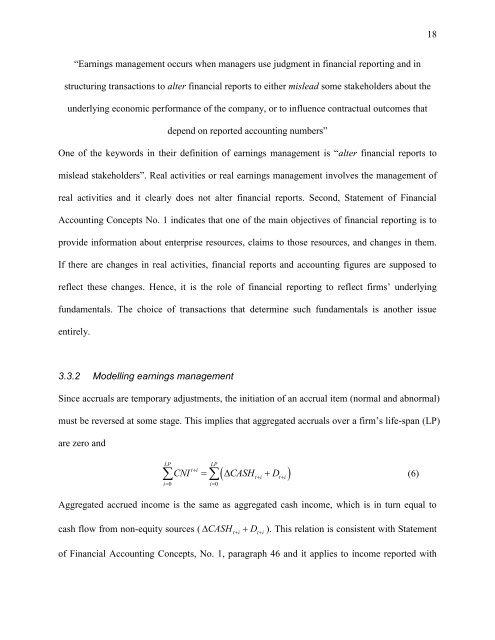Modelling the accruals process and assessing unexpected accruals*
Modelling the accruals process and assessing unexpected accruals*
Modelling the accruals process and assessing unexpected accruals*
You also want an ePaper? Increase the reach of your titles
YUMPU automatically turns print PDFs into web optimized ePapers that Google loves.
“Earnings management occurs when managers use judgment in financial reporting <strong>and</strong> in<br />
structuring transactions to alter financial reports to ei<strong>the</strong>r mislead some stakeholders about <strong>the</strong><br />
underlying economic performance of <strong>the</strong> company, or to influence contractual outcomes that<br />
depend on reported accounting numbers”<br />
One of <strong>the</strong> keywords in <strong>the</strong>ir definition of earnings management is “alter financial reports to<br />
mislead stakeholders”. Real activities or real earnings management involves <strong>the</strong> management of<br />
real activities <strong>and</strong> it clearly does not alter financial reports. Second, Statement of Financial<br />
Accounting Concepts No. 1 indicates that one of <strong>the</strong> main objectives of financial reporting is to<br />
provide information about enterprise resources, claims to those resources, <strong>and</strong> changes in <strong>the</strong>m.<br />
If <strong>the</strong>re are changes in real activities, financial reports <strong>and</strong> accounting figures are supposed to<br />
reflect <strong>the</strong>se changes. Hence, it is <strong>the</strong> role of financial reporting to reflect firms‟ underlying<br />
fundamentals. The choice of transactions that determine such fundamentals is ano<strong>the</strong>r issue<br />
entirely.<br />
3.3.2 <strong>Modelling</strong> earnings management<br />
Since <strong>accruals</strong> are temporary adjustments, <strong>the</strong> initiation of an accrual item (normal <strong>and</strong> abnormal)<br />
must be reversed at some stage. This implies that aggregated <strong>accruals</strong> over a firm‟s life-span (LP)<br />
are zero <strong>and</strong><br />
LP LP<br />
ti CNI CASH tiDti (6)<br />
i0 i0<br />
Aggregated accrued income is <strong>the</strong> same as aggregated cash income, which is in turn equal to<br />
cash flow from non-equity sources ( titi 18<br />
CASH D ). This relation is consistent with Statement<br />
of Financial Accounting Concepts, No. 1, paragraph 46 <strong>and</strong> it applies to income reported with



